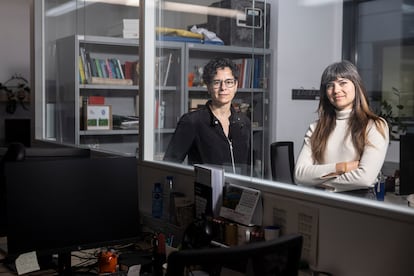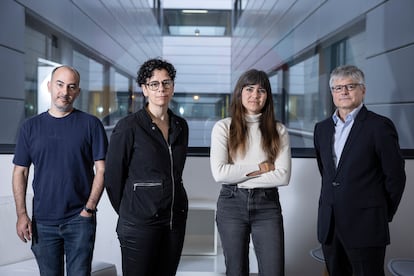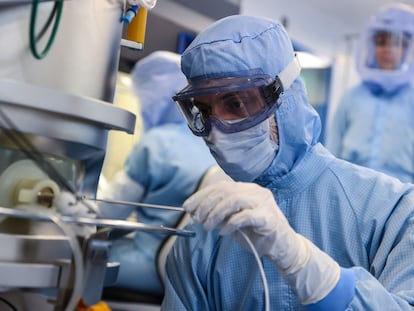On the trail of cancer to understand how and when it originated
A study has explored how a second tumor developed in four children and describes, for the first time, chemotherapy-caused mutations in healthy tissue that have unknown long-term effects

Cancer leaves a molecular fingerprint in the body the very moment it develops. Like the breadcrumbs dropped by Hansel and Gretel, tumors also leave a trace of their route — signals that have now allowed scientists to trace back the path and understand the origin of cancer. A study by researchers at the Institute for Research in Biomedicine in Barcelona (IRB) published on Tuesday in the journal Cancer Discovery has shed light on childhood cancer. It explores the origin of a second tumor in four pediatric cancer patients, with each case representing a distinct pattern of cancer onset. For the first time, researchers have also described mutations caused by chemotherapy in healthy tissue that have unknown long-term effects.
If cancer in childhood is already rare — there is one case for every 200 in adults — it is nearly unheard of for that same patient to develop a second tumor as a child. Especially if they have no underlying genetic disease that predisposes them to develop tumors.
“These are very exceptional and extremely surprising cases for oncologists. It happens very rarely,” explains researcher Núria López-Bigas, the leader of the IRB group that carried out the study. At the Hospital Sant Joan de Déu in Barcelona, where the analyzed cases came from, more than 4,000 children were treated in the last 20 years, and only 30 developed two completely independent tumors (the second is not a relapse of the first) during childhood.
According to López-Bigas, the big question they asked was whether the two tumors in each child had something in common. For example, if they shared a similar origin, such as mutations in cell lineages (a set of cells that come from the same stem cell) from embryonic stages; or if, perhaps, the toxicity of the treatment for the first tumor played a role in the development of the second. Unlike adult cancer, childhood cancer is not usually influenced by environmental factors, but rather by alterations during embryonic development.
With genomic sequencing techniques and advanced bioinformatics, the scientists were able to examine the mutations that triggered the tumor cells and review part of their history. “These tools allow us to reconstruct the history of these tumors, we unravel a part of the cells’ development. We don’t watch it like a movie, but we reconstruct part of their history. The techniques we have used are like a window into the past,” explains the scientist.
The researchers were able to learn, for example, how two cell lineages that gave rise to the two tumors suddenly diverged over time. And they were also able to identify the trace left by platinum-based drugs, a type of chemotherapy.
“If a cell receives platinum, it damages its DNA and builds up platinum mutations. And since we know the day the chemotherapy was administered, we also know the day those mutations were triggered. It’s like a fingerprint that lets us know whether the clonal expansion [when a cell with mutations starts to expand and creates identical cell clones with the same mutations] that gave rise to the second tumor occurred before or after the treatment.” The result of the research revealed a diverse origin of the second tumors.
The first patient described is the only one where a closer link between the impact of chemotherapy and the appearance of the second tumor was seen. When the patient was just over 13 years old, they developed a rhabdomyosarcoma, a type of tumor that affects soft tissues, such as muscles. After treatment with chemotherapy, surgery and radiotherapy, they were cured, but at the age of 17, they developed therapy-related acute myeloid leukemia.
In the molecular study, the authors found platinum-linked mutations in all the leukemia cells, which can only be explained, the researchers note, if that second tumor originated from a cell that expanded after exposure to chemotherapy.
“What we see is that all the leukemia cells share mutations with a single cell after treatment. This means that the tumor was not there before, but we are very cautious: we can say that there was a clonal expansion of the tumor after treatment, but no causal study has been done,” specifies López-Bigas. In any case, therapy-related acute myeloid leukemia is one of the most frequent secondary tumors among cancer patients and accounts for 7% to 8% of all myeloid leukemia detected.
Same mutation, different paths
Another of the cases studied — a child who developed a rare brain tumor at 10 months and a different brain cancer more than eight years later — shows a common origin of the two tumors, explains López-Bigas. “We analyzed the complete genome of the two tumors and looked at how many mutations there are in common,” she says. “There were five. They are very few, which indicates that they occurred very early on, during the first stages of development. But within these mutations, one is the cancer-causing mutation.” The mutation that fueled the onset of both diseases occurred at an early stage, but the tumors followed different paths.

In this case, chemotherapy does not appear to have played a role. “During treatment of the first tumor, the cells [of the second] received mutations, but different cells have different mutations caused by platinum, indicating that the cells of the second tumor had already started to expand before treatment,” the expert concludes.
If clonal expansion had started after treatment, the platinum mutations in the tumor would be the same in all tumor cells. The findings show that the tumors originated at the same time, but the second tumor continued to build up mutations and spread slowly over years “until it became clinically evident,” the scientific article reports.
In the other two cases analyzed, the origin of the tumors is different. Two random mutations during embryonic development led to the appearance of the tumors at different times in the patients’ lives. “These two cases either fall under bad luck or we just don’t quite understand it. But it doesn’t appear that the treatment of the first is implicated in the second, and the tumors don’t share anything that happened early in development. They are different driver mutations [that lead to cancer],” says López-Bigas.
The information obtained from one of these patients, however, has been key to deepening understanding of the long-term impact of the drugs.
Marta’s legacy
Her name was Marta. She was 17 months old when she was diagnosed with a nuroblastoma and, despite the aggressiveness of the tumor, she was cured. But at the age of 10 she was diagnosed with another brain cancer and passed away on August 12, 2019. Her parents, Rosa Pascual and Jordi Gual, agreed for samples to be taken from her tumor and other organs to investigate what had happened. “Apart from knowing what happened to Marta, if doing this can help other families, it helps you a little to make sense of what is happening,” the mother says.
The analysis of the girl’s unaffected organ samples revealed, for the first time, the build-up of mutations in all healthy tissue due to chemotherapy. “Mutations accumulate and many of them have no important implication for people’s lives, but the question remains open as to what role they may play in the evolution of cancer survivors,” says López-Bigas.
Jaume Mora, a pediatric oncologist at Sant Joan de Déu and co-author of the research, explains: “Chemotherapy is an agent that kills cells because it generates alterations in their DNA. Thus, it succeeds in destroying malignant cells, but it also leaves its mark on healthy cells. Thanks to this autopsy, we saw the signature induced by this type of drug. All the tissues had the DNA signature of the platinum-based drugs administered nine years earlier. And now, this opens up a whole can of worms about what happens over many years. We don’t know the mechanism by which the damage occurs. But the DNA damage persists for at least 10 years, and it is possible that this damage explains the long-term effects.”
López-Bigas urges caution when it comes to interpreting the study’s findings. “Chemotherapy, especially in childhood cancer, saves many lives: children are cured and have 70 or 80 years ahead of them. But there is epidemiological evidence that there are side effects due to the treatment that manifest themselves years later, such as an increased risk of tumors or cardiovascular disease,” she explains.
What is not clear, in the scientists’ opinion, is how chemotherapy causes these effects. “At the cellular and molecular level, what chemo does to our cells is not clear, and we want to find this out. One of the things it does is cause mutations,” she explains, but its role in health and disease is still an unknown.
Lucas Moreno, head of pediatric oncology at Vall d’Hebron Hospital in Barcelona, describes the research as “interesting and very elegant.” “The novelty is that the tree of life of the cells is documented. The better the genomics and this type of characterization, the better we will be able to understand what happens in childhood cancer,” he says.
Regarding chemotherapy’s potential impact on the development of a second tumor, the physician — who did not participate in the study — points out: “Chemotherapy and radiotherapy are fundamental for curing children. Thanks to their existence, 85% are cured. The monitoring of their effects is getting better and better, and we are going to make progress to adjust to the minimum that each patient needs.”
“A small step that opens up more questions”
For his part, López-Bigas says that the study will “not change anything in clinical practice overnight,” but is “a small step that opens up more questions.” “We don’t have a final conclusion. There is a different conclusion for every patient. And the question is how chemotherapy-linked mutations affect healthy tissue.” The research, he adds, “contributes to the understanding of cancer and emphasizes the importance of improving treatments”: “We have to think that, once cured, the patient has a very long life ahead of them and their quality of life has to be guaranteed.”
Mora stresses that understanding the origin of tumors “is important for families.” “This explains that the origin of tumors goes back to the first weeks of gestation and, what’s more, it is not transmissible. At that time there is such a complex and massive cell replication process that there are errors. Spontaneous mutation happens without anyone doing anything. It is a natural biological error. The father and the mother are not involved,” explains the oncologist. And knowing this information, she says, bring many families peace of mind.
Marta’s parents attest to this. Knowing the origin of their daughter’s tumors helped them. “It leaves you with the peace of mind that it was inevitable. And if we have been able to help the investigation, even if it is no longer useful for us, it consoles us to think that Marta’s death was not in vain,” says Gual.
Sign up for our weekly newsletter to get more English-language news coverage from EL PAÍS USA Edition
Tu suscripción se está usando en otro dispositivo
¿Quieres añadir otro usuario a tu suscripción?
Si continúas leyendo en este dispositivo, no se podrá leer en el otro.
FlechaTu suscripción se está usando en otro dispositivo y solo puedes acceder a EL PAÍS desde un dispositivo a la vez.
Si quieres compartir tu cuenta, cambia tu suscripción a la modalidad Premium, así podrás añadir otro usuario. Cada uno accederá con su propia cuenta de email, lo que os permitirá personalizar vuestra experiencia en EL PAÍS.
¿Tienes una suscripción de empresa? Accede aquí para contratar más cuentas.
En el caso de no saber quién está usando tu cuenta, te recomendamos cambiar tu contraseña aquí.
Si decides continuar compartiendo tu cuenta, este mensaje se mostrará en tu dispositivo y en el de la otra persona que está usando tu cuenta de forma indefinida, afectando a tu experiencia de lectura. Puedes consultar aquí los términos y condiciones de la suscripción digital.
More information
Archived In
Últimas noticias
Trump claims peace in Ukraine is near, but Moscow suggests otherwise
A survivor’s account of the Interoceanic Train accident: ‘We were scared because of the speed on the curve’
The Interoceanic Train, the Mexican alternative to the Panama Canal
What is known about the Interoceanic Train derailment in Oaxaca
Most viewed
- Oona Chaplin: ‘I told James Cameron that I was living in a treehouse and starting a permaculture project with a friend’
- Reinhard Genzel, Nobel laureate in physics: ‘One-minute videos will never give you the truth’
- Why the price of coffee has skyrocketed: from Brazilian plantations to specialty coffee houses
- Pablo Escobar’s hippos: A serious environmental problem, 40 years on
- Chevy Chase, the beloved comedian who was a monster off camera: ‘Not everyone hated him, just the people who’ve worked with him’











































